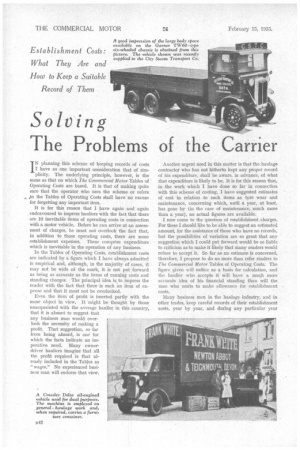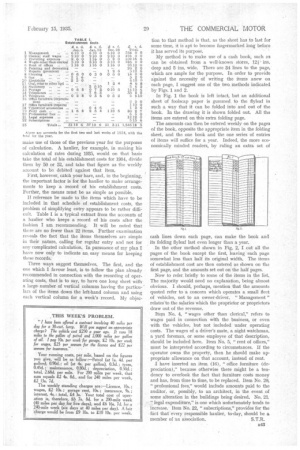Solving The Problems of the Carrier
Page 58

Page 59

If you've noticed an error in this article please click here to report it so we can fix it.
Establishment Costs: What They Are and How to Keep a Suitable Record of Them
IN planning this scheme of keeping records of costs I have as one important oonsideration that of simplicity. The underlying principle, however, is the same as that on which The Commercial Motor Tables of Operating Costs are based. It is that of making quite sure that the operator who uses the scheme or refers
.. ,,to the Tables of Operating Costs shall have no excuse for forgetting any important item.
It is for this reason that I have again and again endeavoured to impress hauliers with the fact that there are 10 inevitable items of operating costs in connection with a motor vehicle. Before he can arrive at an assessment of charges, he must not overlook the fact that, in addition to those operating costs, there are some establishment expenses. These comprise expenditure which is inevitable in the operation of any business.
In the Tables of Operating Costs, establishment costs are indicated by a figure which I have always admitted is empirical and, although, in the majority of cases, it may not be wide of the mark, it is not put forward as being as accurate as the items of running costs and standing charges. The principal idea is to impress the reader with the fact that there is such an item of expense and that it must not be overlooked.
Even the item of profit is inserted partly with the same object in view. It might be thought by those unacquainted with the average haulier in this country, that it is absurd to suggest that any business man would overlook the necessity of making a profit. That suggestion, so far from being absurd, is one for which the facts indicate an imperative need. Many owner driver hauliers imagine that all the profit required is that al ready included in the Tables as "wages." No experienced busi ness man will endorse that view.
Another urgent need in this matter is that the haulage contractor who has not hitherto kept any proper record of his expenditure, shall be aware, in advance, of what that expenditure is likely to be. It is for this reason that, in the work which I have done so far in connection with this scheme of costing, I have suggested estimates of cost in relation to such items as tyre wear and maintenance, concerning which, until a year, at least, has gone by (in the case of maintenance, much more than a year), no actual figures are available.
I now come to the question of establishment charges. For these I should like to be able to suggest an estimated amount, for the assistance of those who have no records, but the possibilities of variation are so great that any suggestion which I could put forward would be so liable to criticism as to make it likely that many readers would refuse to accept it. So far as an estimate is concerned, therefore, I propose to do no more than refer readers to The Commercial Motor Tables of Operating Costs. The figure given will suffice as a basis for calculation, and the haulier who accepts it will have a much more accurate idea of his financial standing than will the man who omits to make allowance for establishment costs.
Many business men in the haulage industry, and in other trades, keep careful records of their establishment costs, year by year, and during any particular year make use of those of the previous year for the purposes of calculation. A haulier, for example, in making his calculation of rates during 1935, would on that basis take the total of his establishment costs for 1934, divide them by 50 or 52, and take that figure as the weekly amount to be debited against that item.
First, however, catch your hare, and, in the beginning, the important factor is for the haulier to make arrangements to keep a record of his establishment costs. Further, the means must be as simple as possible.
If reference be made to the items which have to be included in that schedule of establishment costs, the problem of simplifying entry appears to be rather difficult. Table I is a typical extract from the accounts of a haulier who keeps a record of his costs after the fashion I am recommending. It will be noted that there are no fewer than 22 items. Further examination reveals the fact that the items themselves are simple in their nature, calling for regular entry and not for any complicated calculation. In pursuance of my plan I have now only to indicate an easy means for keeping these records.
Three ways suggest themselves. The first, and the one which I favour least, is to follow the plan already recommended in connection with the recording of operating costs, that is to say, to have one long sheet witha large. number of vertical columns having the particulars of the items down the left-hand column and using each vertical column for a week's record. My objec
-lion to that method is that, as the sheet has to last for some time, it is apt to become fingermarked long before it has served its purpose.
My method is to make use of a cash book, such as can be obtained from a well-known stores, 12$ irtS. deep and 5 ins. wide. There are 34 lines to the page, which are ample for the purpose. In order to provide against the necessity of writing the items anew on each page, I suggest one of the two methods indicated by Figs. 1 and 2.
In Fig. 1 the book is left intact, but an additional sheet of foolscap paper is gummed to the flyleaf in such a way that it can be folded into and out of the book. In the drawing it is shown folded out. All the items are entered on this extra folding page.
The amounts can then be entered weekly on the pages of the book, opposite the appropriate item in the folding sheet, and the one book and the one series of entries of items will suffice for a year. Indeed, the more economically minded readers, by ruling an extra set of cash lines down each page, can make the book and its folding flyleaf last even longer than a year.
In the other method shown in Fig. 2, I cut all the pages of the book except the first, leaving each page somewhat less than half its original width. The items of establishment cost are then entered as shown on the first page, and the amounts set out on the half pages.
Now to refer briefly to some of the items in the list.
The majority would need no explanation, being almost obvious. I should, perhaps, mention that the amounts quoted refer to a concern which operates a small fleet of vehicles, not to an owner-driver. " Management " relates to the salaries which the proprietor or proprietors draw out of the revenue.
Item No. 4, "wages other than clerical," refers to wages paid in connection with the business, or even with the vehicles, but not included under operating costs. The wages of a driver's mate, a night watchman, a yard foreman, or some employee of that description, should be included here. Item No. 5, "rent of offices," must be interpreted according to circumstances. If the operator owns the property, then he should make appropriate allowance on that account, instead of rent.
I have inserted an item (16), "office furniture (de preciation)," because otherwise there might be a tendency to overlook the fact that furniture costs money and has, from time to time, to be replaced, Item No. 20, "professional fees," would include amounts paid to the auditor, or, possibly, to an architect, in the event of some alteration in the buildings being desired. No. 21, " legal expenditure," is one which unfortunately tends to increase. Item No. 22, "subscriptions," provides for the fact that every responsible haulier, to-day, should be a member of an association. S.T.R.




























































































